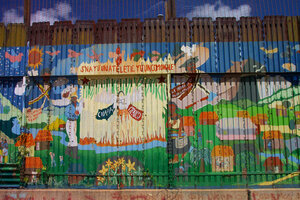Evolution of a border crossing: US to tout fortified fence in Nogales
Our correspondent recalls the evolution of the US-Mexico divide at Nogales, from a simple chain-link fence to a virtual fortress boosted by electronic surveillance.

This undated photo provided by BorderLinks via Nogales International shows part of a 60-foot mural painted on a former landing-mat border fence by the community in Nogales, Sonora, Mexico. The US government is replacing the landing-mat fence with a taller, electronically surveilled version that they say will be safer and more secure.
BorderLinks/AP
Nogales, Arizona and Nogales, Mexico
For as long as I can remember, the border between the two towns where I once lived, both named Nogales, was just a place to cross either north to Arizona or south to Sonora.
It was "la línea," the line. A chain-link fence that, if you so desired, allowed you to catch a glimpse of daily life on either side of the border. If you lived on the Mexican side and lacked a local border-crossing card, you could slip through the ever-present gaps in the fence and shop American for a day. If your home was on the Arizona side, you could use the same gaps as a shortcut to Mexico’s taco stands.
Most of us crossed legally into Arizona through two ports of entry during our back-and-forth excursions to shop, work, and socialize. Those of us who claimed US citizenship didn’t even have to carry proof. But the 1990s ushered in drastic change for Ambos Nogales, a common reference to the towns that share a name and a deep history.
In mid-decade, the 2.8 miles of chain-link fence in the downtown core gave way to a more menacing metal wall fashioned out of corrugated steel once used as military landing mats. Now, the same stretch is being altered again, at a cost of $11.6 million. Today, the government officials will gather to tout the higher, bollard-style fence before the media as a more secure and efficient border.
“It’s more safety for agents; they can see us, we can see them,” Border Patrol agent Jason Rheinfrank told me before the event. “It’s more of a deterrence effect.”
Whatever shapes it takes, the fence is something you learn to live with if either Nogales – the Spanish word for walnut – is home.
Although I’d moved away by the time the landing-mat fences went up, I’d often hear grumblings when I visited friends and relatives who felt it further isolated the two communities from each other. But the growing influx of drug smuggling and illegal border crossings had caught the attention of Washington.
The landing-mat wall frayed relationships between the towns that were vital to the cross-border economies, recalls Santa Cruz County Sheriff Tony Estrada, a lawman in Nogales, Ariz., for four decades. “It was terrible,” he says. "It’s like one day in your backyard your neighbor decides, ‘you know what? I don’t want to see you anymore, so I’m going to put up an ugly wall.’”
In time, artists from both sides of the border turned the side of the wall facing Mexico into a metal canvas that depicted socially-conscious art, including white crosses symbolizing migrants who die traversing the Sonoran Desert.
The 9/11 terrorist attacks intensified security concerns – the Southwest border became a political football and the Nogales fence gradually turned into a virtual fortress, boosted by electronic surveillance and scores of roaming Border Patrol agents. Stray from the ports of entry, too close to the fence, and expect your presence to be questioned.
Although the fortified border has caused strain between the two cities, Mr. Estrada says “it is an unfortunate necessity of the times.”
In late May, I ventured to Ambos Nogales to do some reporting. Wandering in Mexico, I noticed a finished section of the newest fence. Its steel tubes towered high above the nearly empty new plaza where I stood on a late Sunday morning. Before 9/11, before Mexico’s drug war, before the economic crash, this area teemed with American tourists.
I headed back home to Arizona, and soon realized I’d left my passport at home. US Customs detained me for about 20 minutes, until federal employees verified my identity. I then strolled through downtown Nogales, which Mexican shoppers had kept humming for decades. The streets here were quiet, too.
